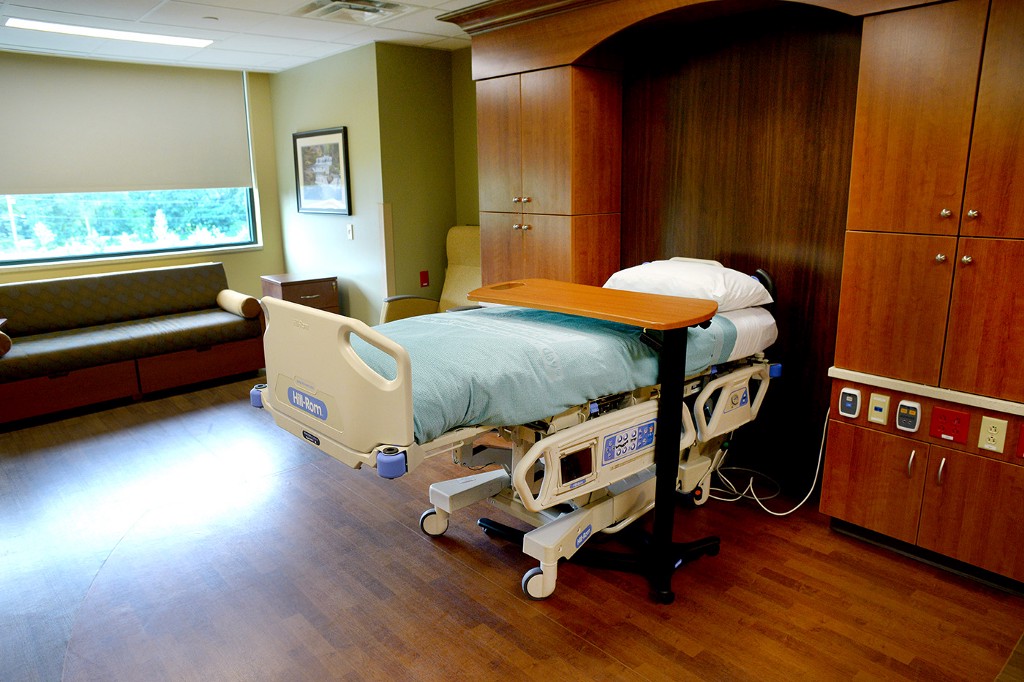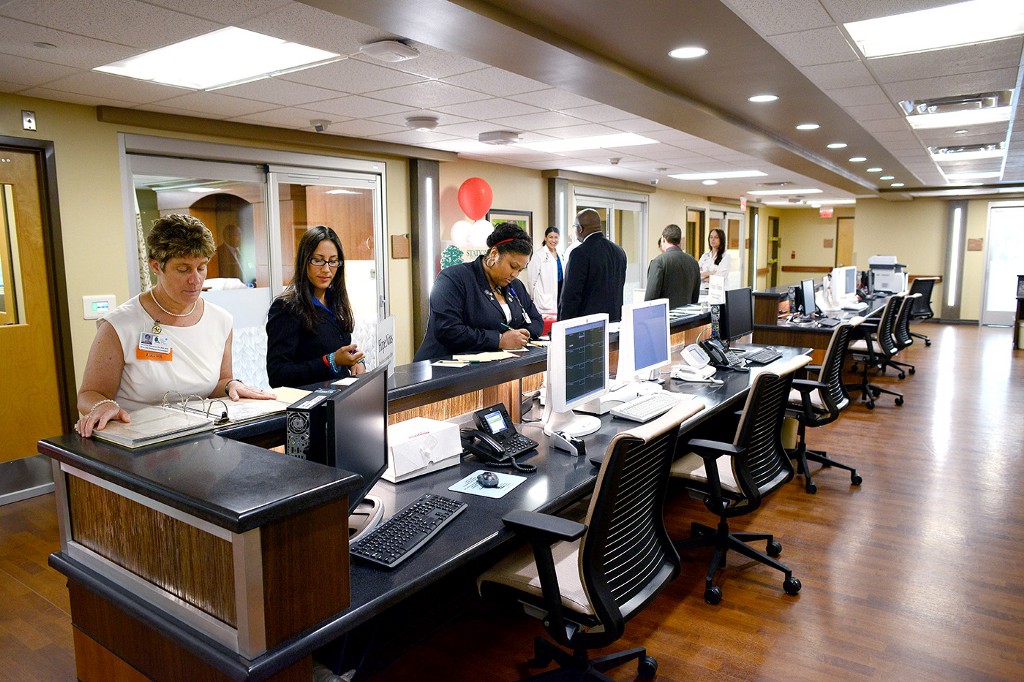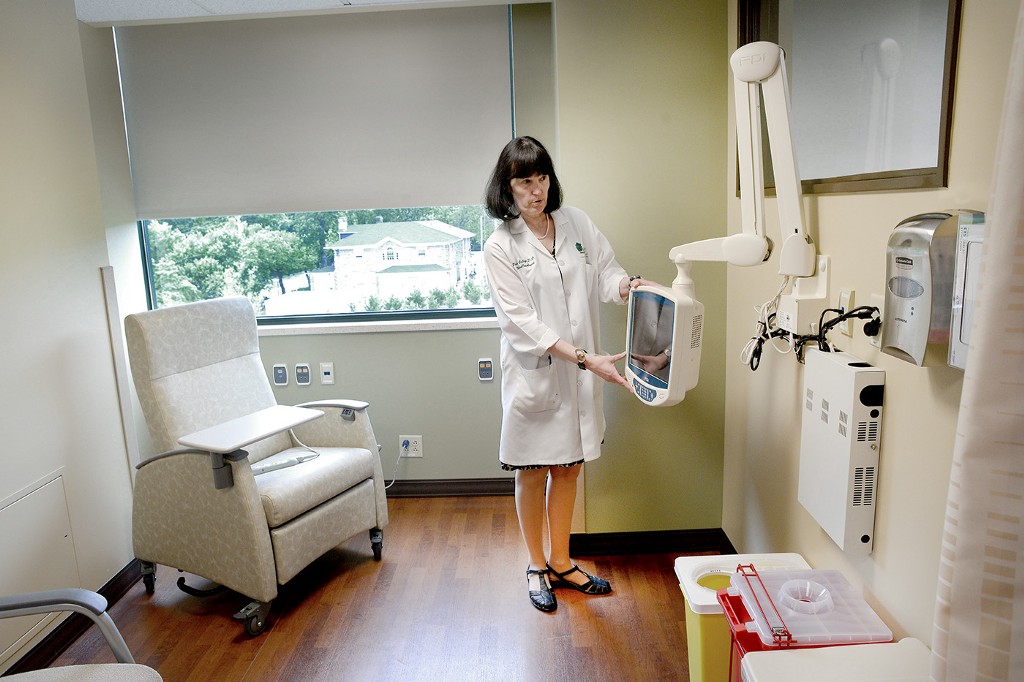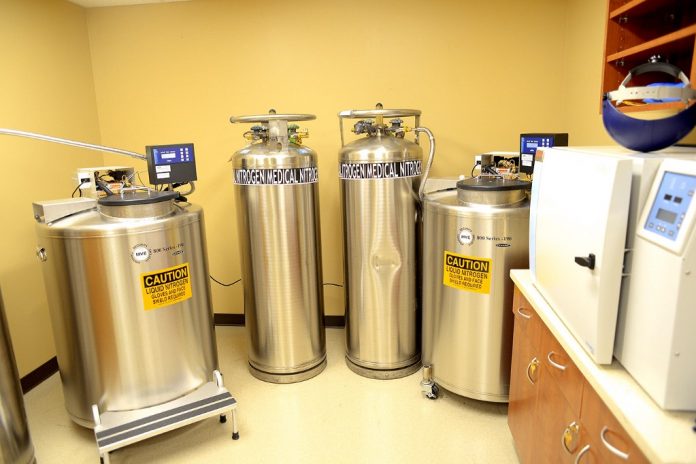One of the hospitals new additions includes a room of liquid nitrogen vaults that store stem cells. MARIA POUCHNIKOVA / TIMES PHOTO
A sign in Cancer Treatment Centers of America’s new stem cell transplant center declares that, “Blood Cancers Have a New Enemy in Town.”
The 17,000-square-foot center includes eight inpatient rooms, an infusion suite and a blood and stem cell collection unit.
Many of the employees have more than two decades of experience in the stem cell transplant field.
“There’s a lot of experience behind this team,” said Regina Mullaney, the stem cell processing manager and 25-year veteran of a similar unit at Hahnemann University Hospital.
The center officially opened on July 1.
The unofficial grand opening on June 27 included a ribbon cutting, open house and concert by the Pointer Sisters in a large enclosed tent in the main parking lot of CTCA, at 1331 E. Wyoming Ave.
One visitor that day was Dr. Siddhartha Mukherjee, author of the Pulitzer Prize-winning book The Emperor of All Maladies: A Biography of Cancer, which is being developed as a six-hour documentary for public television by Ken Burns.
CTCA’s new rogram provides stem cell transplantation therapies and other treatments for patients with hematologic malignancies such as leukemia, lymphoma and multiple myeloma.
“It’s tremendous to have this available for these patients,” Mullaney said.
Such complicated blood cancers often require aggressive treatments and lengthy hospital stays.
After receiving a transplant, the hospital stay can range from a few weeks to a few months, as a patient’s immune system recovers. CTCA accepts many commercial insurance plans and some Medicare plans.
The staff also offers stress management and emotional coping skills for patients and their families. CTCA’s “Patient Empowered Care” team includes a hematologist, dietitian, naturopathic oncology provider, nurse care manager and transplant coordinator.
The hospital’s medical staff will be raising awareness of the Be the Match Registry, operated by the National Marrow Donor Program. Individuals can join the registry with the swab of their cheek.
The new center is located on the hospital’s fourth floor.
“It’s really nice that it is all contiguous on the same floor,” said Dr. Pam Crilley, co-director of the center. “It’s a lot easier for patients.”
The local CTCA hospital is the third in the health-care company to offer a stem cell transplant center, following ones in Zion, Ill. and Tulsa, Okla.
Hospital officials explained that there are two types of stem cells that are used in the transplant therapies: bone marrow and hematopoietic.
Bone marrow is the soft, sponge-like material found inside bones. It contains a specific kind of cell known as hematopoietic cells, which create blood-forming stem cells.
Hematopoietic stem cells divide to form more blood-forming stem cells, or they mature into one of three types of blood cells: white blood cells, which fight infection; red blood cells, which carry oxygen; and platelets, which help the blood to clot.
Most hematopoietic stem cells are found in the bone marrow. But others, called peripheral blood stem cells, are found in the bloodstream.
CTCA took many months putting all the pieces in place.
Lisa Sabol, nurse manager of the new Philadelphia center, has been on the job since March after 30 years at Hahnemann. She credits the staff’s experience and expertise in creating what she thinks will be a lifesaving center.
“It’s the people, technology and all the care that has gone into the preparation of the unit,” she said. “We’re getting patients on the road to recovery.”
The transplant rooms are large and include a recliner, storage space, big windows and a futon that can be used as a bed by a loved one. There are also two televisions, enabling the patient to watch one program and the caregiver to watch another show.
“It’s a clinical setting, so we try to make it as comfortable as possible,” said nurse Heather Brown.
Visitors to the open house had the chance to stop and chat with naturopathic resident Karen Brothers, occupational therapist Joe Domanico, physical therapist/rehabilitation manager Kathryn Doran and registered dietitian Karen Marr.
Patients will need their services as part of their recovery.
“It’s a pretty intense treatment regimen,” Marr said.
Kurrie Wells, a clinical health psychologist, said insurance companies want the best possible outcomes for patients, so they value mind-body medicine.
The hospital offers mind-body medicine before, during and after treatment. It can include support groups, counseling, individual therapy and relaxation techniques to manage stress and discomfort.
“It’s integrative, compassionate care,” said Wells, the new director of CTCA’s mind body medicine program who formerly worked in a similar capacity at Rush University Medical Center in Chicago. “We’re here for the patient and the family.”
Dr. Dave Topolsky is co-director of the center with Crilley, a fellow oncologist and 20-year-plus veteran of Hahnemann.
Topolsky and Crilley cite the state-of-the-art technology and home-away-from-home atmosphere as elements that make the center extra special.
“What’s different is the potential of this unit and the ability to use complementary medicines on a daily basis,” Topolsky said. “We’re enhancing the patient’s stay and outcome.” ••

Part of the CTCA’s new stem cell transplant center. MARIA POUCHNIKOVA / TIMES PHOTO

Part of the CTCA’s new stem cell transplant center. MARIA POUCHNIKOVA / TIMES PHOTO

The new wing: Dr. Pamela Crilley is co-director of the stem cell transplant center at the Cancer Treatment Centers of America. MARIA POUCHNIKOVA / TIMES PHOTO

The new wing: Dr. Pamela Crilley is co-director of the stem cell transplant center at the Cancer Treatment Centers of America. MARIA POUCHNIKOVA / TIMES PHOTO





